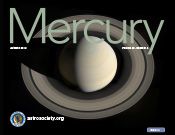Autumn 2013 - Volume 42, Number 4

Table of Contents
[18] ASP Posters from San Jose
Within this issue are five of the 70 posters that were presented at the 2013 ASP Conference in San Jose, California. Here’s an excerpt from one of them.
[31] The Story of Comets and Comet ISON, Alexei V. Filippenko
Is Comet ISON, coming to December’s morning skies, really the “Comet of the Century"?
[39] Astronomy in the News
Voyager 1 enters interstellar space, colliding dead stars may be responsible for Earth’s gold, and a bizarre alignment of planetary nebulae — these are some of the discoveries that recently made news in the astronomical community.
Departments
[4] Perspectives, Paul Deans
Space Oddity
[5] First Word, Jim Manning
New
[7] Annals of Astronomy, Clifford J. Cunningham
Milton's Universe
[8] Astronomer’s Notebook, Jennifer Birriel
Algol: The Oldest Known Variable Star?
[10] Planetary Perspectives, Emily Joseph
The Planets, Sequestered
[11] Armchair Astrophysics, Christopher Wanjek
Black Hole Rejection
[13] Education Matters, David Bruning
When Teaching Inhibits Learning
[14] Reaching Out, Matt Fillingim
Dance Inspired by Astronomy and Physics Research
[16] Societal Impact, Vivian White & Anna Hurst
My Sky Tonight: Exploring Early Childhood Patterns of Engagement with Astronomy Concepts
[46] ASP Tidings
Recently Elected Board Members
[50] Sky Sights, Paul Deans
Comet ISON Arrives
[53] Reflections, Paul Deans
Aurora During a Weak Solar Maximum
“Wibbly-Wobbly, Timey-Wimey Stuff: Teaching with a Time Lord”
by Kristine Larsen
November 2013 marks the 50th anniversary of the premiere of Doctor Who, the longest-running science fiction television series in history. This BBC series follows the adventures of “the Doctor,” a two-hearted millennium-old Time Lord from the planet Gallifrey, as he explores space, time, and alternate universes in the TARDIS (short for Time and Relative Dimensions in Space). His myriad (often human) companions marvel that the TARDIS (which has the exterior appearance of a 1960s British Police Box) is much bigger on the inside. Time Lords have the ability to completely renew their own exterior appearance and to some extent their personality (known as “regeneration”), allowing for a number of actors to serially portray the Doctor.
This poster will give examples of astronomical topics in Doctor Who that are often covered in Astro 101 type courses as well as suggestions for integrating these examples into the classroom. For the sake of brevity and to capitalize on the popularity of the 2005 revival, only episodes starring the 9th, 10th, and 11th doctors (portrayed by Christopher Eccleston, David Tennant, and Matt Smith, respectively) will be included.
The Story of Comets and Comet ISON
by Alexei V. Filippenko
Comet ISON was discovered on September 21, 2012. Right away people got really excited about it, and some rather fantastic headlines — unfortunately inspired, in part, by astronomers — appeared just about immediately after it was announced. “New Comet Might Blaze Brighter than the Full Moon.” Well, that’s technically true; it might! Then, “Newly Spotted Comet May Outshine the Full Moon.” So, will it? Read on.
Comets appear as diffuse, luminous patches in the sky, often with long tails. In fact the word comet comes from the Greek aster komētēs, which means “long-haired star.” In ancient cultures, comets have been widely viewed as bad omens — messengers of the gods proclaiming that there’s going to be some sort of terrible disaster coming; essentially harbingers of doom, death, and destruction! In William Shakespeare’s Julius Caesar, Calphurnia tells Caesar: “When beggars die, there are no comets seen; the heavens themselves blaze forth the death of princes.” And even among some people today, this is still believed to be the case.
Changes in Comet Rotation May be Predicted With Greater Accuracy
Planetary Science Institute
Planetary Science Institute researchers have discovered a way to predict the changes in the rotational states of comets that could help scientists learn more about the approaching Comet C/2012 S1 (ISON), which will pass by the Sun on Thanksgiving Day and has attracted worldwide interest because it may become sufficiently bright to be seen by the naked eye.
PSI Senior Scientists Nalin H. Samarasinha and Beatrice E.A. Mueller have determined such changes are a function of a comet’s size, period, and solar energy it receives, but surprisingly not a function of the fraction of a comet’s surface that is active.
“You get more change if there is more solar energy and less change if it is spinning more rapidly to begin with or if it is a larger comet. Larger, rapidly rotating comets are not going to change their spin status very much,” Samarasinha said. “We expected that the fraction of the surface of the comet that is active would also be a controlling factor, but that proved not to be the case.”
Applying their method to Comet ISON, Samarasinha and Mueller conclude it will spin-up and will become a tumbling object as it gets close to the Sun. The spin-up of ISON could result in increased shedding of material from the nucleus as it is subjected to solar tides and intense heating during its close passage by the Sun.
“While these mass sheddings may result in interesting events for astronomers, we hope the nucleus of Comet ISON is sufficiently large to avoid complete disruption — an outcome common to many sungrazing comets,” Mueller said.
